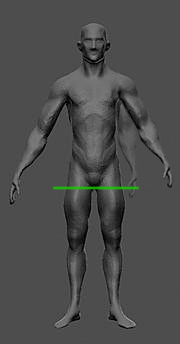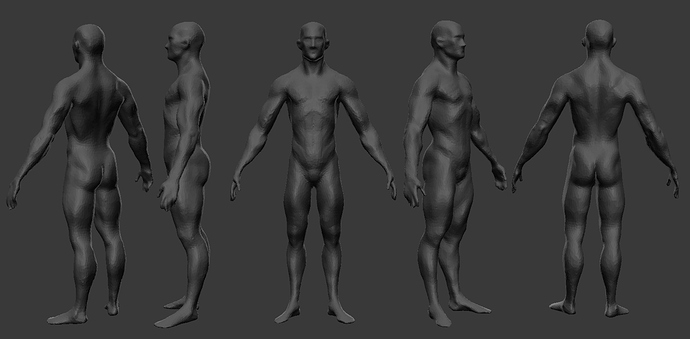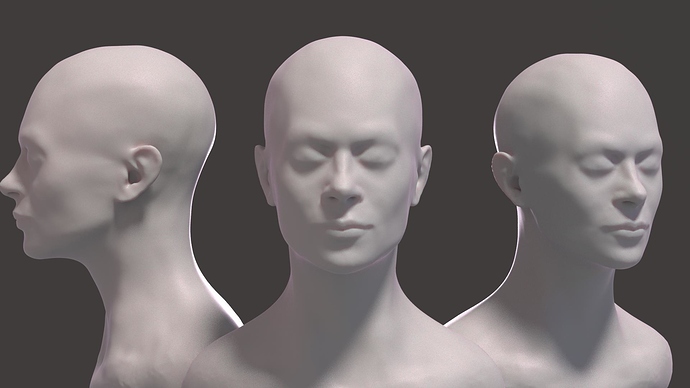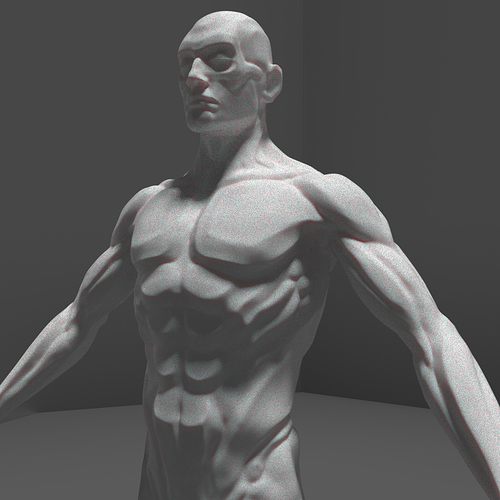Chipmasque! very nice information!!! I think that you are totally right, In this days, I use Orthographic just to measure, or to use the backdrop image, and to sculpt I go to 80 or 90, and some times 70, (fore sure I never sculpt in Orthographic) Then I spend some time just looking at 50, to see if everything is working.
Wen I have references, I change a lot the lens to approximate the lens of the references, I think that my brain is caching up the 3d space and the difference distances (mm of the lens), and it is making the conversions quicker and quicker every time.
For the renders… well… I suck at render… I never like my renders, so I keep changing every parameter, every time, so I don’t know. but I see it more like taking a picture with a camera, so you can chose different cameras. It is like more of an artistic approach.
Yeah. I use orthographic myself in the early stages of most of the stuff I do. Switching to perspective as it progresses. I often go with 50 myself. 35 has always felt too much like a fish-eye lens to me. 
Applying values and calculations are useful, especially when trying to understand why something isn’t working the way you’d like or expect. But in the end how you feel about the result is all that matters. And whether or not you’ve achieved what you set out to do.
There is a simple reason I said do it all in perspective. If you nail it in perspective you have nailed it in orthographic. If you nail it in orthographic view often it looks very wrong in perspective.
Try it out as an exercise sculpt a bust completely in perspective with a nice camera lens 50 - 100, don’t go into ortho mode once. Then at the end when you feel you are done, 100% done go into ortho mode and you will see that everything will look completely fine and when it comes to render there will be no surprises.
Ortho mode for organics is just a crutch, ditch the training wheels…
Tyrant Monkey, I can’t say at this point that I disagree with you because I see that I need less and less to go to ortho, but I still think that for measuring purpose, (it was always the use I did of ortho) it is a valid approach. And I can tell you that I did what you are saying, and it is true, it can be done, no doubt about it. But still I don’t understand why you say it is bad to use the ortho to block the mass, you can be a lot more analytic, and remove your brain deformations, if you know the proportions, if you don’t know them and you are guessing, then what you are saying may be true.
Maybe there is a way to measure in blender, an addon or something that I don’t know, but if you have to measure by view, you have to go to ortho.
Some practice: pure dynotopo, inspire by codywinch and his sketchbook
It is not totally shit and it seems better because of the gesture, that is not to bad. I think gesture is one of the more important thing to make a bunch of vertex, feel like a humanoid.
@Tyrant Monkey! I have to say you where totally right! there is not need for ortho, In real life you can measure and you never have ortho view, you can just go to 100 mm or 120 mm to measure, and you never get that strange view. I see now that I make some errors in my sculpting because of ortho.
So thank you!
Nice sculpt Tonatiuh. Only thing I have to point out is the wrist feels a bit slim in the front and back view. And I agree with the use of persepective view when sculpting, but I do use ortho at times to check the background images from time to time.
Do what ever works for you. If that involves orthographic then so be it. If not. Fine. It’s not a catchall situation.
It doesn’t apply to everyone.
If you’re going for proportions the wrists do seem a little flat and thin. And the arms themselves look slightly long. If the arms were down by the legs it may look a bit better having the knuckles in line with the crotch. That’s just a personal observation though. Not an expert critique. Real people don’t always fit what we might consider idealised proportions. 
And there’s nothing “shit” about the sculpt by the way.
Attachments

Thanks CodyWinch, Yes, the wrist are really bad, and the arms in general, it is not a good sculpt, I just want to feel the gesture, to showcase may feeling that gesture is more important that individual features.
@Macser You are totally right about the arms, I know some swimmers, that have very log arms, but in general it is not the normal phenotype person.
I mean shit because I didn’t put effort to make all work well, just to make the gesture work, but thanks!
Some practice (not study because I didn’t use references) of a female face, just trying to apply things I have learned, but keep it simple to see if with out much details, you can clearly see some signs of “life”. I think it can.
Also I wanted to experiment with the constant detail of dynotopo as @Doris suggested to me. I think I may like it, still fighting against Dynotopo.
Inspire by the t0xik’s Sketchbook
Some corrections, Back of the skull, placement of the ears, eyes back, some chin corrections, and some neck adjustment.
Very nice Tona!
Tonatiuh you are definitely superior at sculpting. I am curious what is the secret of your superiority ? what is your workflow ? 
it seems specializing is more important than being generalist
by the way for the women bust i really love the way you make of the eye socket
@nureintier!!! Thanks! I really don’t see my self to be good, but I put a lot of brains and mind to it.
I can tell you my secret, but YOU HAVE TO PROMISE to NOT TELL anyone!!!:
1- I study a lot of human proportions. (andrew loomis)
2- I study a lot of anatomy. Years and Years, but not for art, but for my profession (physiotherapist-Osteopathy)
3- I study a lot (not practice) study is wen you do some draw or some sculpture, following references.
4- I see a lot of sculpting video tutorials.
5- I use a lot of references.
6- I try to help others.
And for workflow… I don’t really see that I have one, but I can think on some workflow (I’m really learning blender, like in 4 or 5 months of real use)
1- I change the lens to 80 or 90 or 100 mm, but never never 35 mm
2- I do a subsurface subdivision of the cube until it becomes a sphere.
3- I activate dynotopo. (constant detail and subdivide collapse, Thanks to @Doris (she is really good, not like me))
4- Then well… I do a lot of things, it all depends, in what I want to sculpt, but I use snake hook, to extrude things, or the grab tool to move things, some inflate, some scrape, some clay… you know.
5- I think a lot in proportions, in anatomy, in the gesture, and in the look and FEEL.
Well, you know that this is TOP SECRET!
Playing a little with my Loomis-Base-Mesh-Male-V0.1 hehehehe
some kind of hard surface, I wanted to see the volume as clearly as possible.
Looking good, Tonatiuh, You seem to play very well with Dyntopo. I have not yet tried it, as my muscle system uses just modeled forms for the sake of animation ease, but I really should. I’ve sculpted in Blender using Multires but found it slow and troublesome, so I kind of avoid it. Perhaps Dyntopo will be more amenable. I sculpt in wax and clay in the real world, so it should be a natural for me to sculpt digitally, but it’s always been a bit of a struggle for me.








